Contents
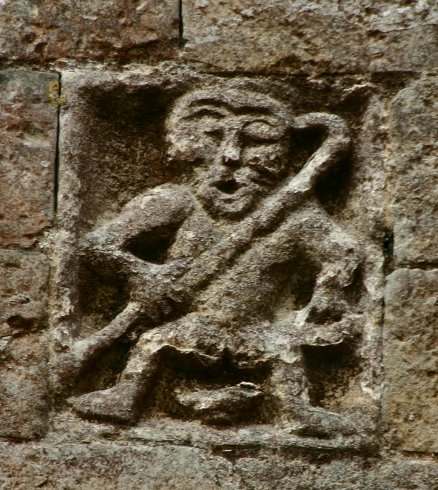
This figure is situated on the Norman Abbey in Romsey. the current church is the third to stand on the site but has been a place of worship for at least 1000 years going back to Saxon times. Romsey Abbey is widely regarded as one of the best examples of Norman church architecture still standing.
A Sheela with objects
This sheela is unusual in that it is accompanied by a number of objects. The figure holds a crooked staff which has been interpreted as a crozier. The staff is said to indicate that the figure is meant to be the abbess. There is also a hard to identify object in the figure’s left hand which has been identified as shears. However Richard N Bailey examined this figure close up on scaffolding and dismissed this interpretation in his paper Apotropaic Figures in Milan and North-West England (point 12). As you can see in the photograph on the left the object does not appear very scissor like. The figure straddles what appears to be a now damaged bowl. The vulva is indicated by a small notch and is not very prominent.
The Nun on the Potty
The figure was known locally by schoolchildren1 in the past as “The nun on the potty” this is probably due to the fact that there appears to be something between the figures splayed legs. This object appears to be a damaged pot hence the local name for it. Indeed the figure may be a combination of exhibitionist and an “at stool” figure although there does not appear to be any sign of a stool.
A Miserly Sheela?
Whereas it’s very hard to determine what the unidentified object is, my personal theory is that it’s a purse ring . See Melbourne Church’s Miser Figure for an example of a purse ring. In December 2006 I revisted Melbourne and took some more detailed pictures of the “miser” figure and found that the object that the figure was holding actually included what seems to be the sack of the purse as well. If you compare the Romsey figure to the Melbourne one they both seem to be holding what appear to be very similar objects. This would seem to fit into the alleged satirical nature of the carving as the purse ring is used in Romanesque carving to indicate miserliness. This would mean that carving has been used to imortalise the abbess’s niggardliness possibly in paying the sculptors. However there a problems with this theory in that the purse ring is usually depicted as a open D shape which the object only just resembles. We should also be a little wary of the satirical explanation as this is one frequently used to explain rude or out of place carvings on churches. A similar story is told about the Kilpeck figure and many other anomalous (to our eyes) church carvings. One odd fact is that the carving was originally in position where it could not be seen easily. This begs the question could this be a genuine example of a “mason’s joke”. There are however a number of features that would argue against the satirical nature. The carving is not a quick piece of graffiti but a well carved and detailed panel. It would have taken a significant amount of time to carve taking a sculptor away from other more visible and authorised work. As with most speculation on these figures the fact is we will never really know. There could however be another explanation for the figure which involves a royal scandal and an abbess who became a wife.
A Royal Scandal – Mary de Blois
Tradition has it that two sculpted heads on a capital in the South Transept at Romsey represent King Stephen and his ill fated daughter Mary of Blois. As was the custom in the 12th century Mary was dedicated to a religious life as a child by her mother Matilida. She was placed in the priory of Stratford-atte-Bow in Middlesex along with a group of nuns from St Sulpice in Rennes who were attend to her upbringing. Apparently the strict rule of the English nuns did not sit well with French group who were used to a more lenient regime. No doubt the importance of their royal charge also contributed to the friction. Unfortunately this strife was taste of what was to come for the young princess. Some years later Queen Matilda founded a new priory at Lillechurch in Kent and at the tender age of sixteen Mary found herself the prioress of the St Sulpice nuns.The rents from Lillechurch manor were made over to Stratford priory to cover the costs of the new sister house. It would seem that relations did not improve despite the move and few years later Stratford priory rescinded any claim to Lillechurch on the condition that Mary’s group packed up their bags and left forthwith. During her time at Lillechurch her mother Matilda and her father King Stephen died leaving Henry II to suceeded to the throne. Henry was of a different family to Mary and so her fortunes dwindled somewhat.
It seems easy to read between the lines in this history that group were troublesome and not easy to control. Whatever the reason the group left Kent and were sent to Romsey some time between 1156 and 1158 where Mary was appointed new Abbess. The choice of Romsey was not unusual as it had a tradition of housing those of royal blood who took to the cloisters. Mary began a quiet life at Romsey until 1159 when Mary’s brother William died leaving her the sole heiress of her families estates including Boulogne in France.
It is at this point that scandal rocks 12th century Europe.
King Henry II sees an opportunity to strengthen his alliances on the continent by marrying Mary, despite the fact she is an abbess with accompanying vows of chastity, to Matthew of Alsace the younger son of the count of Flanders. Thomas a Beckett’s horror at the scarelige of this marriage is written about by a number of writers of the period. All but one of the chroniclers of the period paint Mary as the innocent party in this scandal. For a short time she was the “innocent object of execration” 2 of most of Europe. The marriage led to the excommunication of Matthew but not that of Mary which seems to indicate that she was seen as an innocent party in this sacreligious union.
Sheela na gig or Mary of Blois?
Does this mean then that the carving at Romsey is actually a record of this scandal? The figure definitely represents a ecclesiastical figure due to the prescence of the crozier. The other objects though are more troublesome, a pot which the figure squats over and looped object held in the left hand which may be a purse representing money. For the most part Mary was seen as the innocent party so is it likely that she would be villified in a satirical piece of sculpture? Despite this the sculpture does seem to represent an abbess and even though Mary was widely believed to be innocent there was a school of thought that she could have objected more strongly had she wished to. Given that Mary’s ecclesiastical career was a matter of circumstance rather than conviction would she have welcomed the marriage? Apparently not as a later letter to the King of France makers clear her hatred of King Henry and it would appear she did not welcome the marriage at all. Nevertheless we have a sexual sculpture of what appears to be an abbess and a sexual scandal involving an abbess both of which come from the same period. Unfortunately there is no definite proof that they are connected.
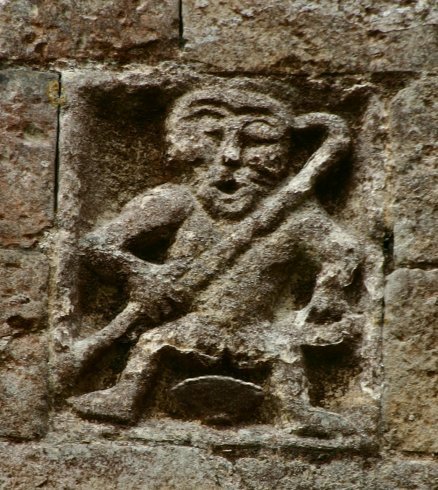
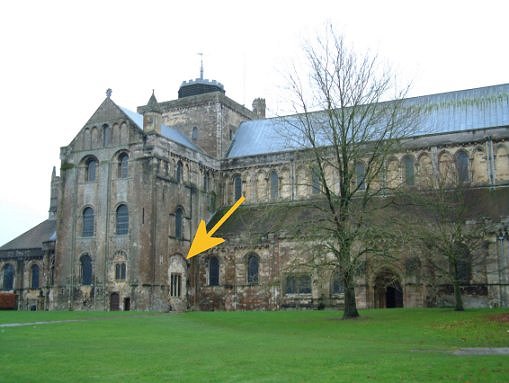
Romsey Abbey. The arrow indicates the position of the sheela na gig carving. The birthing corbel is on the adjacent lower corbel table.
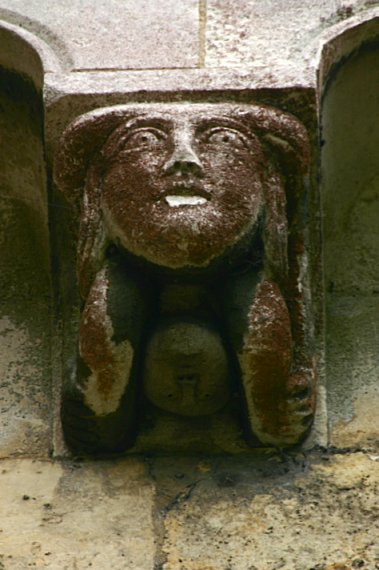
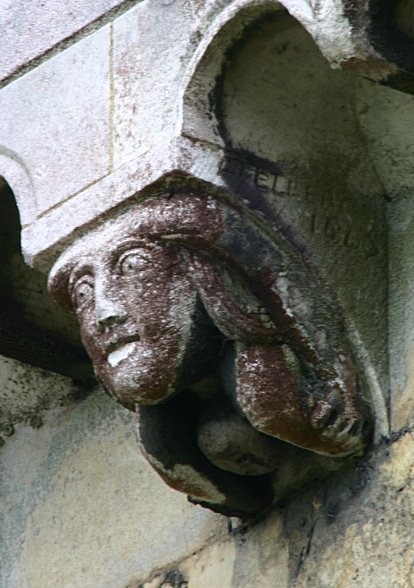
Unlike most church sculpture we have a likely sculptor for this corbel as he has kindly left his signature on the side of the figure. The name Ellery is fairly easy to make out with a possible date of 1865 below. A Thomas Ellery is recorded in Harrod & Co.’s Directory of Hampshire & Isle of Wight, 1865 “Thomas ELLERY, stone and marble mason, Middle Bridge street, Romsey”. Unfortunately only Ellery is clear with some scratches possibly indicating initials. It’s thought that this corbel is a replacement for an original romanesque corbel of a similar design.
- The late Wendy McKenna local resident and archaeologist.
- Lives of the Princesses of England M.A. Everret Green 1849
- Romsey Abbey Through the Centuries by Judy Walker Pendragon Press 1993